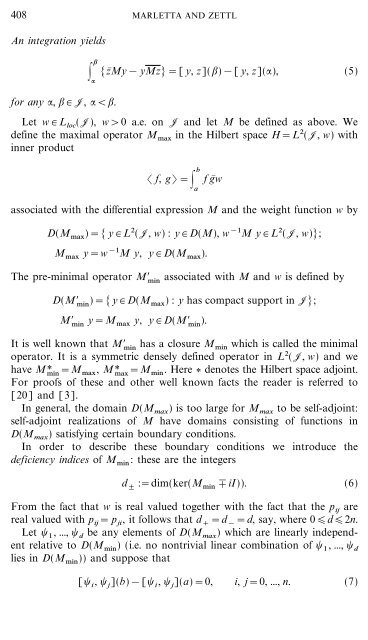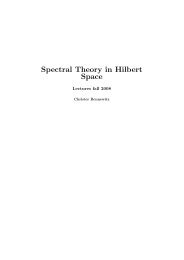The Friedrichs Extension of Singular Differential Operators
The Friedrichs Extension of Singular Differential Operators
The Friedrichs Extension of Singular Differential Operators
You also want an ePaper? Increase the reach of your titles
YUMPU automatically turns print PDFs into web optimized ePapers that Google loves.
408 MARLETTA AND ZETTL<br />
An integration yields<br />
| ;<br />
:<br />
for any :, ; # J, :0 a.e. on J and let M be defined as above. We<br />
define the maximal operator M max in the Hilbert space H=L 2 (J, w) with<br />
inner product<br />
(f, g)=| b<br />
fgw<br />
associated with the differential expression M and the weight function w by<br />
D(M max)=[y# L 2 (J, w) :y # D(M), w &1 My# L 2 (J, w)];<br />
M max y=w &1 My, y # D(M max).<br />
<strong>The</strong> pre-minimal operator M$ min associated with M and w is defined by<br />
D(M$ min)=[y# D(M max) :y has compact support in J];<br />
M$ min y=M max y, y # D(M$ min ).<br />
It is well known that M$ min has a closure M min which is called the minimal<br />
operator. It is a symmetric densely defined operator in L 2 (J, w) and we<br />
have M* min =M max, M* max =M min. Here V denotes the Hilbert space adjoint.<br />
For pro<strong>of</strong>s <strong>of</strong> these and other well known facts the reader is referred to<br />
[20] and [3].<br />
In general, the domain D(M max) is too large for M max to be self-adjoint:<br />
self-adjoint realizations <strong>of</strong> M have domains consisting <strong>of</strong> functions in<br />
D(M max) satisfying certain boundary conditions.<br />
In order to describe these boundary conditions we introduce the<br />
deficiency indices <strong>of</strong> M min: these are the integers<br />
a<br />
d \ :=dim(ker(M min iI)). (6)<br />
From the fact that w is real valued together with the fact that the p ij are<br />
real valued with p ij= p ji, it follows that d +=d &=d, say, where 0 d 2n.<br />
Let 1, ..., d be any elements <strong>of</strong> D(M max) which are linearly independent<br />
relative to D(M min) (i.e. no nontrivial linear combination <strong>of</strong> 1, ..., d<br />
lies in D(M min)) and suppose that<br />
[ i, j](b)&[ i, j](a)=0, i, j=0, ..., n. (7)



